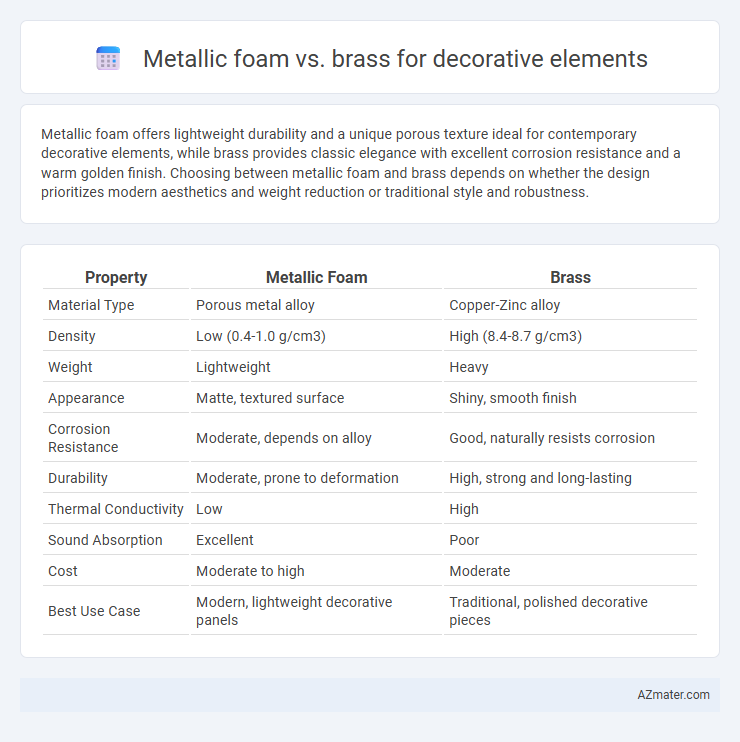Metallic foam offers lightweight durability and a unique porous texture ideal for contemporary decorative elements, while brass provides classic elegance with excellent corrosion resistance and a warm golden finish. Choosing between metallic foam and brass depends on whether the design prioritizes modern aesthetics and weight reduction or traditional style and robustness.
Table of Comparison
| Property | Metallic Foam | Brass |
|---|---|---|
| Material Type | Porous metal alloy | Copper-Zinc alloy |
| Density | Low (0.4-1.0 g/cm3) | High (8.4-8.7 g/cm3) |
| Weight | Lightweight | Heavy |
| Appearance | Matte, textured surface | Shiny, smooth finish |
| Corrosion Resistance | Moderate, depends on alloy | Good, naturally resists corrosion |
| Durability | Moderate, prone to deformation | High, strong and long-lasting |
| Thermal Conductivity | Low | High |
| Sound Absorption | Excellent | Poor |
| Cost | Moderate to high | Moderate |
| Best Use Case | Modern, lightweight decorative panels | Traditional, polished decorative pieces |
Introduction to Metallic Foam and Brass in Decoration
Metallic foam offers lightweight structure, high porosity, and unique texture that enhances aesthetic appeal and acoustic properties in decorative elements. Brass provides a classic, durable, and corrosion-resistant finish with warm metallic tone ideal for traditional and luxurious design themes. Comparing their use in decoration, metallic foam delivers innovative, modern looks with enhanced ventilation, while brass emphasizes timeless elegance and robustness.
Material Composition and Properties Comparison
Metallic foam is primarily composed of metal alloys such as aluminum or steel, characterized by a porous structure that provides lightweight properties and high energy absorption, making it ideal for modern decorative elements requiring a unique texture and durability. Brass, an alloy of copper and zinc, offers excellent corrosion resistance, a smooth finish, and superior malleability, which supports intricate detailing and a traditional aesthetic in decorative applications. The choice between metallic foam and brass depends on the desired balance between lightweight design with structural benefits and classic, polished appearance with ease of craftsmanship.
Visual Appeal: Texture and Aesthetics
Metallic foam offers a unique porous texture with a modern, industrial aesthetic that creates depth and visual interest through its irregular surface patterns. Brass provides a smooth, polished finish with warm golden hues that evoke a classic, luxurious feel ideal for timeless decorative elements. The choice between metallic foam and brass depends on whether one prefers contemporary ruggedness or traditional elegance in texture and color.
Durability and Longevity Differences
Metallic foam exhibits superior corrosion resistance and impact absorption compared to brass, making it more durable in harsh environments. Brass, while aesthetically pleasing, is prone to tarnishing and slight deformation under mechanical stress, reducing its longevity in outdoor or high-traffic decorative applications. The porous structure of metallic foam also provides enhanced wear resistance, extending the lifespan of decorative elements beyond that of traditional brass components.
Weight and Structural Considerations
Metallic foam offers a significantly lighter alternative to solid brass, reducing overall weight without compromising basic structural integrity, making it ideal for large decorative elements where ease of installation is crucial. Brass provides superior strength and durability with a higher density, making it suitable for smaller decorative pieces requiring robust support but adding notable weight to the structure. Weight considerations favor metallic foam in applications prioritizing minimal load, while brass ensures long-term stability and resistance to deformation under stress.
Cost Analysis and Budget Implications
Metallic foam offers a cost-effective alternative to brass for decorative elements due to its lower raw material and manufacturing expenses, resulting in reduced overall budget requirements. Brass, while providing superior durability and classic aesthetic appeal, typically incurs higher costs linked to material price, machining, and finishing processes. Choosing metallic foam can significantly optimize budget allocation without compromising design flexibility in decorative applications.
Customization and Design Flexibility
Metallic foam offers exceptional customization and design flexibility due to its lightweight structure and porous surface, allowing intricate shapes and textures at a lower cost compared to brass. Brass, while traditionally valued for its rich golden hue and durability, is less adaptable in complex forms, making it more suitable for classic or straightforward decorative elements. Designers favor metallic foam for innovative, contemporary aesthetics where unique patterns and enhanced acoustic or thermal properties are desired.
Maintenance and Care Requirements
Metallic foam requires minimal maintenance due to its corrosion-resistant properties and lightweight structure, making it ideal for outdoor decorative elements exposed to harsh weather. Brass, while visually appealing with its warm golden hue, demands regular polishing and cleaning to prevent tarnishing and maintain its shine. Choosing metallic foam reduces long-term upkeep costs and extends the lifespan of decorative installations compared to brass.
Environmental Impact and Sustainability
Metallic foam offers superior environmental benefits compared to brass due to its lightweight structure, which reduces material usage and energy consumption during manufacturing and transportation. Brass, composed of copper and zinc, involves mining processes with higher environmental footprints and limited recyclability compared to metallic foam made from aluminum or steel alloys that boast higher recycling rates. Choosing metallic foam for decorative elements supports sustainability goals by minimizing resource depletion and enhancing energy efficiency throughout the product lifecycle.
Application Examples in Modern Decor
Metallic foam, with its lightweight structure and porous texture, is increasingly used in modern decor as decorative panels, light diffusers, and accent wall features, providing a futuristic and industrial aesthetic. Brass, known for its durability and warm golden hue, is commonly employed in fixtures, handles, and ornamental trims, adding a classic and luxurious touch to interiors. Both materials offer unique visual and tactile contrasts that enhance contemporary design themes by balancing bold structural details with elegant finishes.

Infographic: Metallic foam vs Brass for Decorative element
 azmater.com
azmater.com